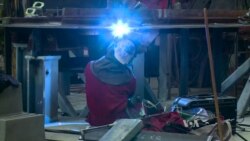A rising tide of automation and some trade deals have cost the United States millions of manufacturing jobs in recent years, leaving many people unemployed or in jobs with poor pay, few benefits, and no future.
At the same time, many U.S. companies say they cannot find enough people with technical skills to fill critical jobs that pay well. Many advanced nations, like Germany and Denmark, make wide use of apprenticeships, but U.S. firms have cut back sharply on them.
One major U.S. firm, however, is using old school techniques that blend classwork and practical experience to build and maintain its high-tech workforce. Newport News Shipbuilding in Virginia has been training apprentices for nearly a century in the many skills needed to build the world's most advanced warships. Those skills range from welding to making computer models to old-style drafting.
Nuclear-powered submarines
Apprentice Jordan Lacy is part of a large crew that is building a nuclear-powered attack submarine, the USS New Jersey. He has been busy sorting out complex steel parts, welding them together, and grinding them smooth so they fit just right.
He says his work "starts as a pile of pieces. When it leaves, it is a finished unit [piece of a ship].”
Lacy, a first-year apprentice, also has worked on a nuclear-powered aircraft carrier, and looks forward to switching from paper plans to computer drawings.
He works in the shipyard a couple of days a week, and spends the rest of his time in classrooms, studying technical topics. He aspires to learn how to design projects, not just assemble them.
Lacy and more than 700 fellow students at the site's Apprentice School are paid for their work while they learn advanced skills.
Practical training
Everett Jordan, who graduated from the Apprentice School decades ago, is now the director of education. He says the school's mix of classroom and practical training pays for the company.
“That graduate has been down in the tanks, the bowels of these ships; they know these complex pipe assemblies; they know what it takes to be a test electrician, they've done it and they take that experience with them the rest of their career,” said Jordan.
Efforts to boost workforce skills through apprenticeships are more common in Germany, Denmark and other nations than the United States, says Edward Alden, author of Failure to Adjust, a new book about problems in the U.S. workforce.
“Apprenticeships are essentially an investment by companies into their future, and the future of their communities," said Alden. "We saw over the decade of the 2000's a 40 percent decline in apprenticeships being offered by [American] private companies."
As ships become more complex, the kinds of skills needed by builders are also growing. The Apprentice School offers 19 basic programs and many advanced ones for workers who display strong skills and aptitude.
Computer modeling is one example. Recent projects included one that showed workers how to deal with a potentially devastating radiation emergency. Another program helps engineers and officers figure out how to speed refueling and rearming of planes on the crowded deck of an aircraft carrier to get them back into combat.
Apprentice Elise Feldt works on another computer modeling project that helps guide workers in the process of removing worn out nuclear reactors from the USS Enterprise. It was the world's first nuclear-powered aircraft carrier and now, after decades of service, is being disassembled.
Academics, experience
Its eight nuclear reactors weigh tons and could emit dangerous radiation, so figuring out the right sequence for the process of safely handing them is crucial.
Feldt, who earlier trained as a pipefitter, relishes the new challenges.
“I love what I do and I think the best part about it is the problem-solving and having to learn and understand so much of what I’m getting into,” said Feldt.
Many apprentices rise to the top or their craft, and a few become top managers. All are informed by practical experience as well as academic skills.
School director Jordan observes that this recipe “absolutely” could help many Americans displaced from manufacturing jobs.
The shipyard employs about 20,000 people — 3,000 of them from the Apprentice School.







